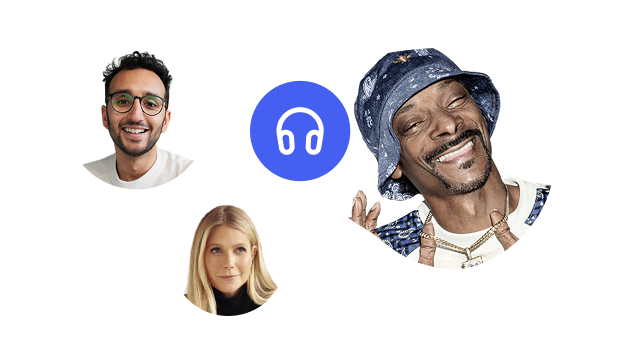Reading through long reports, client emails, or research documents can take hours, time that could be spent strategizing, problem-solving, or leading. That’s where text to speech (TTS) technology comes in. By turning written text into natural-sounding audio, professionals can listen to their work materials anywhere, at the office, in the car, or on the treadmill, turning downtime into productive time. To boost productivity, accessibility, and focus in the workplace, let’s explore everything you need to know about text to speech for professionals.
Why Text to Speech is Essential for Professionals
Text to speech software uses artificial intelligence to convert written digital content, emails, reports, web pages, or articles, into audio that sounds natural and clear. Originally developed to help individuals with reading disabilities or visual impairments, text to speech has evolved into a mainstream productivity tool for professionals. For business leaders, consultants, and creatives, TTS allows multitasking without sacrificing comprehension. Listening instead of reading helps you absorb information more efficiently while staying mobile. It also supports accessibility and inclusion in the workplace, ensuring all team members can access written materials regardless of learning or visual challenges.
How Text to Speech Boosts Workplace Productivity
By using text to speech, professionals can:
Turn Reading Time into Listening Time
Time management is one of the greatest challenges for professionals. Between meetings, emails, and deadlines, long reading tasks often pile up. With text-to-speech, you can turn passive time—commuting, exercising, or organizing—into productive learning moments. With apps like Speechify can adjust the playback speed, follow along with highlighted text, and even pause or resume seamlessly across devices. This lets you review essential information faster without sacrificing comprehension.
Improve Retention and Comprehension
Listening activates different cognitive processes than silent reading. For many professionals, hearing content read aloud enhances memory retention and understanding, especially when processing complex reports or technical materials. Speechify’s synchronized highlighting feature allows users to follow the spoken text visually, reinforcing learning through both auditory and visual channels. This dual-sensory experience helps users stay engaged and retain details longer, which is perfect for fields that demand precision, such as law, medicine, or finance.
Multitask Without Losing Focus
Professionals thrive on efficiency. Text to speech allows you to consume content while performing other low-focus tasks, like driving or exercising, without losing track of key information. By converting your reading load into spoken audio, you can absorb more knowledge during moments that would otherwise go unused.
Real-world Uses of Text to Speech in Professional Settings
Text to Speech technology is transforming professional environments by enhancing accessibility, streamlining communication, and boosting productivity across industries. Here’s just a few use cases of text to speech in the professional world:
Text to Speech For Business Executives and Entrepreneurs
Executives are constantly inundated with reports, strategy documents, and performance updates. With text to speech, leaders can stay informed without having to sit in front of a screen. TTS apps can convert these files into spoken audio that can be played during travel or between meetings—allowing decision-makers to stay ahead with minimal downtime.
Text to Speech For Writers, Editors, and Content Creators
Professionals in creative fields often use text-to-speech as a proofreading and editing tool. Hearing your writing read aloud helps identify awkward phrasing, pacing issues, or repeated words that are hard to catch visually. Many professional authors and journalists use text to speech as a “final pass” before submitting manuscripts or articles.
Text to Speech For Legal, Medical, and Technical Professionals
In fields that require precision, missing a detail can have major consequences. Lawyers, doctors, and engineers use TTS to review documentation efficiently. Legal teams can listen to depositions, while doctors can review case notes during rounds. With OCR (Optical Character Recognition) features, even printed or handwritten documents can be read aloud instantly.
How Text to Speech Improves Accessibility and Inclusion at Work
Accessibility isn’t just an HR requirement; it’s a cornerstone of inclusive company culture. Text to speech ensures that employees with dyslexia, ADHD, visual impairments, or cognitive challenges can fully participate in workplace communication. By making reports, announcements, and training materials available in audio form, businesses demonstrate a commitment to equity and inclusion. Text to speech tools like Speechify align with Universal Design for Learning (UDL) principles, giving every employee multiple ways to access and understand information.
The Cognitive Edge: Why Professionals Retain More Through Listening According to Science
Modern neuroscience supports what many professionals already experience—listening engages the brain differently than reading. When you listen, you process tone, rhythm, and emphasis, which improves comprehension and long-term recall.
Text to speech tools amplify this advantage by offering realistic voices that mimic natural human speech patterns. For auditory learners, this makes the experience not just more engaging, but also more effective. By combining reading and listening, professionals can double their retention rate and stay sharper throughout the day.
Best Practices for Using Text to Speech in Professional Workflows
To maximize the benefits of text-to-speech technology, professionals should approach it strategically:
- Start your day with audio summaries – Use Speechify’s AI Summaries to catch up on reports or articles while commuting.
- Pair audio with visual reading – Following along visually enhances understanding and helps with note-taking.
- Integrate across devices – Keep your workflow consistent between desktop and mobile for seamless productivity.
- Adjust playback speed – Match the pace to your comfort level; faster for scanning, slower for comprehension.
- Use TTS for training and onboarding – Convert company handbooks and manuals into audio form for new hires.
Speechify: The Leading Text to Speech Tool for Professionals
With over 1,000 realistic AI voices in more than 60 languages and accents, Speechify allows professionals to listen to documents, emails, web pages, and Google Docs effortlessly. Users can adjust playback speed up to 4.5x faster for efficient information consumption, generate AI summaries to grasp lengthy documents in seconds, and use AI Quiz or AI Chat tools to test comprehension or discuss insights. The platform also offers seamless cross-device syncing between phone, desktop, and tablet, along with audio exports for offline or on-the-go listening. Together, these tools make Speechify not just a reading aid but a powerful productivity companion for executives, marketers, healthcare specialists, educators, and professionals across all industries.
FAQ
How does Speechify help professionals save time?
Speechify lets users convert any text—emails, reports, PDFs—into spoken audio, allowing multitasking and reducing screen time.
Can text to speech improve focus at work?
Yes. Listening with text to speech apps like Speechify helps reduce cognitive overload and eye strain while keeping attention steady, especially during long or dense reading tasks.
Is Speechify secure for business use?
Yes, Speechify uses secure cloud processing and does not store private content without user consent, ensuring safety for confidential materials.
What industries benefit most from text to speech?
Every field can benefit, but it’s especially valuable in business, healthcare, law, education, and creative industries where professionals deal with large volumes of text.
Can Speechify help professionals manage heavy reading loads?
Yes, Speechify reads lengthy reports, legal documents, and research papers aloud, reducing eye strain and saving valuable time.





